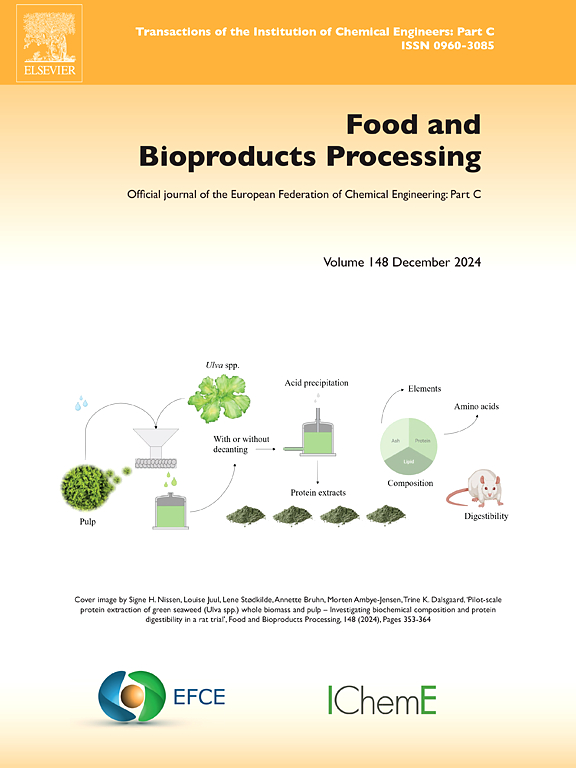Incorporation of microbubbles into milk pasteurization for fouling mitigation
IF 3.4
2区 农林科学
Q2 BIOTECHNOLOGY & APPLIED MICROBIOLOGY
引用次数: 0
Abstract
The dairy industry faces significant challenges of fouling formation in processing equipment, which accounts for about 80 % of the total operating costs. In this study, we incorporated microbubbles (MBs), i.e., fine air bubbles with a respective diameter of 10 −100 μm, into milk and investigated their effect on fouling formation during pasteurization. Skim and whole milks were thermally treated using a spinning disc apparatus (SDA) operated at an initial surface temperature of 95 °C and different disc rotational speeds (50–150 rpm) to generate shear stress from 0.063–0.15 Pa, and MBs were infused into milk using a venturi-type generator. Computational fluid dynamics (CFD) simulations were performed to model the interactions between the flow and MBs in the SDA. Simulations indicated that MBs accumulated in the vicinity of the disc with average density decreasing by 60 % as the disc rotational speed increased from 50 to 150 rpm. The fouling curves revealed that the presence of MBs in milk caused removal of formed deposit, resulting in less fouling in all cases. Among the types of milk and shear stresses tested, MBs led to the largest reduction in fouling when incorporated into skim milk and operated under 0.077 Pa, from 0.0134 to 0.0052 m2K/W. Besides, protein carbonyl measurements showed that MB treatments did not induce protein oxidation in milk. The results proved that MBs can serve as a novel agent for incorporation into milk pasteurization to effectively mitigate fouling formation in heat exchanger, thereby reducing the operating costs and improving the productivity of dairy processing plants.
在牛奶巴氏杀菌中加入微气泡以减少污染
乳制品行业面临着加工设备形成污垢的重大挑战,这约占总运营成本的80% %。在这项研究中,我们将微气泡(mb),即直径为10 −100 μm的细气泡加入牛奶中,并研究了它们对巴氏杀菌过程中污垢形成的影响。采用旋转圆盘装置(SDA)对脱脂牛奶和全脂牛奶进行热处理,初始表面温度为95℃,旋转圆盘转速为50-150 rpm,产生0.063-0.15 Pa的剪切应力,并使用文氏里式发生器将mb注入牛奶中。利用计算流体力学(CFD)模拟了SDA内流动与mb之间的相互作用。模拟结果表明,当圆盘转速从50转/分增加到150转/分 转/分时,mb在圆盘附近聚集,平均密度下降了60% %。污垢曲线显示,MBs在牛奶中的存在导致了形成沉积物的去除,在所有情况下都减少了污垢。在测试的牛奶和剪切应力类型中,当加入脱脂牛奶并在0.077 Pa下工作时,MBs的污垢减少幅度最大,从0.0134降至0.0052 m2K/W。此外,蛋白质羰基测定表明,MB处理没有引起牛奶中蛋白质氧化。结果表明,MBs可以作为一种新型的掺入牛奶巴氏杀菌剂,有效地减少热交换器中的污垢形成,从而降低乳制品加工厂的运营成本,提高生产率。
本文章由计算机程序翻译,如有差异,请以英文原文为准。
求助全文
约1分钟内获得全文
求助全文
来源期刊

Food and Bioproducts Processing
工程技术-工程:化工
CiteScore
9.70
自引率
4.30%
发文量
115
审稿时长
24 days
期刊介绍:
Official Journal of the European Federation of Chemical Engineering:
Part C
FBP aims to be the principal international journal for publication of high quality, original papers in the branches of engineering and science dedicated to the safe processing of biological products. It is the only journal to exploit the synergy between biotechnology, bioprocessing and food engineering.
Papers showing how research results can be used in engineering design, and accounts of experimental or theoretical research work bringing new perspectives to established principles, highlighting unsolved problems or indicating directions for future research, are particularly welcome. Contributions that deal with new developments in equipment or processes and that can be given quantitative expression are encouraged. The journal is especially interested in papers that extend the boundaries of food and bioproducts processing.
The journal has a strong emphasis on the interface between engineering and food or bioproducts. Papers that are not likely to be published are those:
• Primarily concerned with food formulation
• That use experimental design techniques to obtain response surfaces but gain little insight from them
• That are empirical and ignore established mechanistic models, e.g., empirical drying curves
• That are primarily concerned about sensory evaluation and colour
• Concern the extraction, encapsulation and/or antioxidant activity of a specific biological material without providing insight that could be applied to a similar but different material,
• Containing only chemical analyses of biological materials.
 求助内容:
求助内容: 应助结果提醒方式:
应助结果提醒方式:


